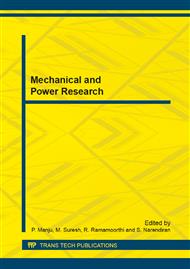[1]
R. P. Brent, The parallel evaluation of general arithmetic expressions, J. Assoc. Comput. Mach., vol. 21, no. 2, p.201–206, Apr. (1974).
Google Scholar
[2]
G. Govindu, R. Scrofano, and V. K. Prasanna, A library of parameterizable floating-point cores for FPGAs and their application to scientific computing, in Proc. Int. Conf. Eng. Reconfigurable Syst. Algorithms, 2005, p.137–148.
Google Scholar
[3]
R. Scrofano, L. Zhuo and V.K. Prasanna, Area-Efficient Arithmetic Exprexxion Evaluation Using Deeply Pipelined Floating-Point Cores, IEEE Transactions on VLSI systems, vol. 16, no. 2, pp.167-176, (2008).
DOI: 10.1109/tvlsi.2007.912038
Google Scholar
[4]
L. Zhuo and V. K. Prasanna, Scalable modular algorithms for floating point matrix multiplication on FPGAs, in Proceedings of the 11th Reconfigurable Architectures Workshop (RAW 2004), April (2004).
DOI: 10.1109/ipdps.2004.1303036
Google Scholar
[5]
IEEE Standard for Binary Floating-Point Arithmetic, 1985, IEEE Std.
Google Scholar
[6]
L. Louca, T. A. Cook, and W. H. Johnson, Implementation of IEEE Single precision floating point addition and multiplication on FPGAs, in Proceedings of the IEEE Symposium on FPGAs for Custom Computing Machines, April (1996).
DOI: 10.1109/fpga.1996.564761
Google Scholar
[7]
P. Belanovic and M. Leeser, A library of parameterized floating point modules and their use, in Proceedings of the 12th International Conference on Field Programmable Logic and Applications, M. Glesner, P. Zipf, and Valley, CA), April (2003).
Google Scholar
[8]
Yee Jern Chong, and Sri Parameswaran, Memeber IEEE, Configurable Multimode Embedded Floating Units for FPGAs, IEEE Transactions on Very Large Scale Integration Systems, vol. 19, no. 11, November (2011).
DOI: 10.1109/tvlsi.2010.2072996
Google Scholar
[9]
Ruzica Jevtic and carlos Carreras, Power Estimation of Embedded Multiplier blocks in FPGAs, IEEE Transactions on Very Large Scale Integration Systems, vol. 18, no. 5, May (2010).
DOI: 10.1109/tvlsi.2009.2015326
Google Scholar
[10]
ChiWaiYu, Alastair M. Smith, Wayne Luk, Philip H. W. Leong, Optimizing Floating Point Units in Hybrid FPGAs, IEEE Transactions on Very Large Scale Integration Systems, vol. 20, no. 7, July (2012).
DOI: 10.1109/tvlsi.2011.2153883
Google Scholar
[11]
Yiran Chen, hai Li, Cheng-kok koh, Guangyu Sun, Jing Li, yuan Xie and Kaushik Roy, Variable Latency Adder Designs for Low power and NBTI Tolerance, IEEE Transactions on Very Large Scale Integration Systems, vol. 18, no. 11, November (2010).
DOI: 10.1109/tvlsi.2009.2026280
Google Scholar
[12]
A. Akkas, Dual-mode quadruple precision floating pointadder, inproc. 9th Euromicro Conf. Digit. Syst. Des, 2006, pp.211-220.
DOI: 10.1109/dsd.2006.47
Google Scholar
[13]
A. Akkas and M.J. Schulte, A quadruple precision and dual precision floating point multiplier, in proc. 9thEuromicroConf. Digit. Syst. Des, 2003, p.76.
DOI: 10.1109/dsd.2003.1231903
Google Scholar
[14]
G. Even, S. M. Mueller, and P. -M. Seidel, A dual precision IEEE floating-point multiplier, Integr. VLSI J., vol. 29, no. 2, p.167–180, (2000).
DOI: 10.1016/s0167-9260(00)00006-7
Google Scholar
[15]
U. Meyer-Baese, Digital Signal processing with Field Programmable Gate Arrays, Springer, 2nd edition.
DOI: 10.1007/978-3-662-04613-5
Google Scholar


